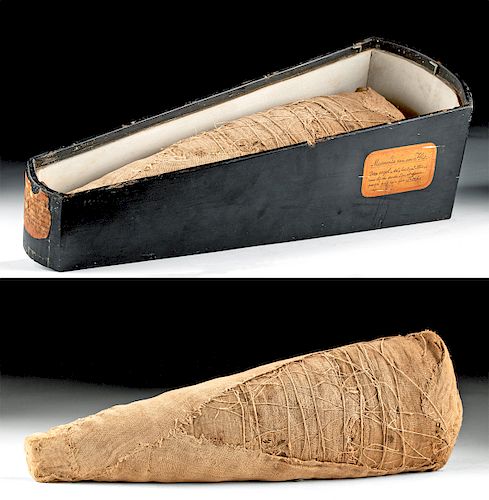Egyptian Mummified Ibis & 19th C. Dutch Museum Box
Lot 5e
About Seller
Artemis Fine Arts
686 S Taylor Ave, Ste 106
Louisville, CO 80027
United States
Selling antiquities, ancient and ethnographic art online since 1993, Artemis Gallery specializes in Classical Antiquities (Egyptian, Greek, Roman, Near Eastern), Asian, Pre-Columbian, African / Tribal / Oceanographic art. Our extensive inventory includes pottery, stone, metal, wood, glass and textil...Read more
Estimate:
$7,000 - $10,000
Absentee vs Live bid
Two ways to bid:
- Leave a max absentee bid and the platform will bid on your behalf up to your maximum bid during the live auction.
- Bid live during the auction and your bids will be submitted real-time to the auctioneer.
Bid Increments
| Price | Bid Increment |
|---|---|
| $0 | $25 |
| $300 | $50 |
| $1,000 | $100 |
| $2,000 | $250 |
| $5,000 | $500 |
| $10,000 | $1,000 |
| $20,000 | $2,500 |
| $50,000 | $5,000 |
| $100,000 | $10,000 |
| $200,000 | $20,000 |
About Auction
By Artemis Fine Arts
Sep 26, 2019
Set Reminder
2019-09-26 10:00:00
2019-09-26 10:00:00
America/New_York
Bidsquare
Bidsquare : Exceptional Day 1: Antiquities & Asian Art
https://www.bidsquare.com/auctions/artemis-gallery/exceptional-day-1-antiquities-asian-art-4437
Day 1 of an important 2-day auction featuring exceptional, museum-worthy examples of Egyptian, Greek, Etruscan, Roman, Viking, Russian, Near Eastern, as well as Asian Art from China, Japan, Thailand, Vietnam, Burma and India. Artemis Fine Arts info@artemisgallery.com
Day 1 of an important 2-day auction featuring exceptional, museum-worthy examples of Egyptian, Greek, Etruscan, Roman, Viking, Russian, Near Eastern, as well as Asian Art from China, Japan, Thailand, Vietnam, Burma and India. Artemis Fine Arts info@artemisgallery.com
- Lot Description
Ancient Egypt, Late Period, ca. 712 to 300 BCE. An incredibly-preserved bundle containing the body of a mummified sacred ibis. The bird's body is folded into a crouch and wrapped tightly in woven textiles, most of which remain. The mummy may have once had a bronze head attached to its front, which was common practice for these ibis mummies. This example that clearly contains the actual body of the bird is rarer than you may assume - recent research suggests that up to a third of Egyptian animal mummy bundles only contain partial animals or are even just bundled cloth, made by ancient embalmers to sell to gullible pilgrims. Comes with custom display box with old collection labels in Dutch. Size of bundle: 5" W x 14" H (12.7 cm x 35.6 cm); size of box, which is wood and glass: 6" L x 4.5" W x 15" H (15.2 cm x 11.4 cm x 38.1 cm)
The ibis, an elegant, long-legged wading bird that lives along the shores of the Nile, was associated with the god Thoth and, later, the sage Imhotep. He was the god of wisdom and writing, and in worship to him ibises were ritually sacrificed, embalmed, and mummified before being buried in underground galleries. CT-scans on some of these mummies have revealed that many were fed posthumously. Their stomachs were removed during the mummification process, and, via an incision, a small parcel of food - mainly snails - was inserted before they were carefully replaced in the bird's chest cavity. As shocking as it may seem, there were millions of these burials, many of which have been excavated at Saqqara, near Memphis, Egypt's ancient capital. Others, like this one, were found at Abydos, one of Egypt's oldest cities, where many pharaohs were entombed. Especially during the Late Period, the Egyptians seem to have been obsessed with ibis (and other animal) mummies, which, in the case of ibises, were used to gain Thoth's favor. A pious individual would go to the temple, pay a priest to intercede with Thoth for them, and the priest would mummify an ibis.
This item was originally collected by Rev. Leendert Schouten (1825-1905) for his Bijbels Museum in Amsterdam. This museum sought to recreate stories from the Bible, and to that end Schouten focused on cultures in that area, especially Egypt and Israel. His collection of models of the Temple of Solomon, the Tabernacle and the model of the Haram-es-Sherif are world famous pieces.
Provenance: private J.H. collection, Beaverton, Oregon, USA; ex-Bijbels Museum in Amsterdam, Holland, collected by Rev. Leendert Schouten (1825-1905)
All items legal to buy/sell under U.S. Statute covering cultural patrimony Code 2600, CHAPTER 14, and are guaranteed to be as described or your money back.
A Certificate of Authenticity will accompany all winning bids.
We ship worldwide and handle all shipping in-house for your convenience.
#149651See X-rays to look inside - you can clearly see bones and the long skull! The textile around the bundle is in nice condition, with a few small holes, staining and slight unraveling as shown. Display box is ca. 19th century CE with Dutch labels. These labels are somewhat difficult to read because of age but are generally decipherable. The box is wood and glass, with light wear commensurate with age, but overall in nice condition.Condition
- Shipping Info
-
All shipping is handled in-house for your convenience. Your invoice from Artemis Gallery will include shipping calculation instructions. If in doubt, please inquire BEFORE bidding for estimated shipping costs for individual items.
-
- Buyer's Premium



 EUR
EUR CAD
CAD AUD
AUD GBP
GBP MXN
MXN HKD
HKD CNY
CNY MYR
MYR SEK
SEK SGD
SGD CHF
CHF THB
THB

















